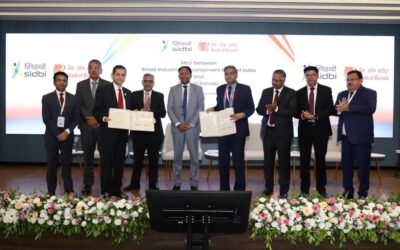India’s Textile Export Resilience: What Diversification and Leading Firms Reveal about India’s Global Potential

India’s textile sector is navigating one of its most turbulent global trade phases in recent memory. With the imposition of 50% tariffs by the United States (effective 27 August 2025) that raised duties on ready-made garments (RMG) to 63.9%, the country’s largest apparel export market was under severe pressure. Given the US represents approximately US$ 10.8 billion, or 35%, of Indian textile shipments last year, a large contraction was anticipated. Instead, India has demonstrated a noteworthy degree of resilience through a strategy of diversification, targeted market outreach and leveraging its domestic industry base.
Between April–September 2025, India recorded 10% year-on-year export growth across 111 countries, reaching US$ 8.49 billion, up from US$ 7.72 billion in the same period the previous year an absolute growth of US$ 770 million. Meanwhile, exports to the United States fell by 2.6% to about US$ 5.2 billion. Global textile and apparel exports rose only 0.1% in the same period, which underscores India’s above-average performance.
A closer breakdown shows the extent of diversification: exports to 38 countries rose by more than 50%, to 16 markets by 25-50%, and to another 57 markets by under 25%. Emerging destinations such as Egypt (27%), Hong Kong (69%), and Saudi Arabia (12.5%) saw significant momentum. Established markets UAE (14.5%), Japan (19%), Spain (9%), France (9.2%), Germany (2.9%), and UK (1.5%) also registered growth, albeit more modestly.
Even under tariff stress, India’s RMG exports grew by 3.42%, and jute exports by 5.56%, signifying broader resilience rather than a single-segment surge.
Leading firms
To provide context and credibility to the national trends, it is helpful to highlight specific companies that play a major role and whose strategies mirror the sectoral shift.
- Gokaldas Exports (GOKL.NS) is a publicly listed apparel manufacturer that exports to major US retailers (Walmart, Gap, JCPenney). According to Reuters, Gokaldas produces around 90 million garments annually and generated revenue of approx. ₹38.64 billion (US$ 438.97 million) in FY2025. The company reports that about 75% of its standalone sales come from the US market, and in response to the US tariffs has redirected focus toward the European Union and UK export markets. This corporate case underscores how firms are adapting by shifting destination focus.
- Page Industries Ltd is one of India’s prominent apparel manufacturers and retailer/licensor of brands such as Jockey. While detailed export figures are not publicly broken out in our sources, the company is referenced as a major exporter and domestic leader. Its presence reinforces the theme that India hosts globally integrated textile firms capable of competing internationally.
- Alok Industries Ltd, which has diversified into home textiles, technical textiles, garments and exports to over 90 countries, recorded export growth of 77.55% from Rs 957.20 crore to Rs 1,699.54 crore in a recent year. Though smaller in scale relative to national totals, this illustrates the high-growth potential within publicly-trading firms.
These firm-level examples affirm that India’s textile supply base is not only resilient but already actively repositioning for global market shifts. The shift is not purely about exports increasing, but about strategic adaptation whether redirecting market focus, expanding product segments (technical textiles / man-made fibres) or investing in value-added capabilities.
Diversification was not overnight
The government’s response was deliberate. Recognising India’s modest 5-6% market share in many export destinations, public policy identified 40 priority markets spanning North America, Europe, Asia, Africa, Latin America and Oceania. These markets were historically underpenetrated and became the focus of aggressive export promotion.
Export-Promotion Councils, Indian trade missions abroad and cluster-based outreach started positioning India not just as a low-cost manufacturer, but as a reliable, sustainable supplier of quality-textiles. Categories identified for focus included apparel, home-textiles, technical-textiles and handicrafts.
Importantly, India’s trade strategy placed emphasis on Free-Trade Agreements (FTAs). The recently signed India–UK Comprehensive Economic and Trade Agreement (CETA) forms part of this. FTAs have the potential to counter India’s tariff disadvantage in major markets especially relevant given competing low-cost countries such as Bangladesh, Vietnam, Mexico and Central America.
In short, diversification was engineered via both market outreach and product-category reorientation, aligning India’s export base to sustainable growth models.
What Happens If India Becomes More Business-Friendly?
Despite the encouraging export numbers and firm-level adaptation, India’s textile-export potential remains far from exhausted. If India tackles structural impediments and creates a more business‐friendly environment, the export trajectory accelerates.
1. Achieving the US$ 100 billion Target by 2030 Is Realistic – But only with structural reform
India currently exports around US$ 37.7 billion worth of textiles. The government has set a target of US$ 100 billion by 2030. Given the 10% growth across 111 countries even amid tariff shocks, the target is not aspirational it could be feasible. However, success hinges on:
- Accelerated FTAs improving market access and neutralising tariff disadvantages.
- Simplification of compliance and regulatory regime (especially for MSMEs).
- Upgraded infrastructure (ports, customs clearance, logistics chain) reducing turnaround time and cost.
- Integrated cluster investment in technology, design, R&D especially for higher‐value segments such as technical textiles.
- Enhanced connectedness with global value chains beyond purely low-cost manufacturing.
2. Opportunity to Replace China in Mid-Value Segments
Global sourcing strategies increasingly reflect “China + 1” models. India is positioned to capture displacement of manufacturing from China in segments such as:
- Functional apparel (activewear, athleisure)
- Home-textiles and décor
- Medical/industrial textiles (technical textiles)
- Eco-friendly, sustainable fibre products
The expansion of firms such as Alok Industries and others into technical textiles underscores that the building blocks already exist. The key is scaling and linking to global buyers.
3. Employment and Cluster Growth Implications
With export pressures earlier industry estimates warned of 15–20 lakh job losses absent diversification. The fact that exports-maintained growth suggests job losses may have been avoided, but also that job gains are possible. If India becomes smoother to do business in:
- MSME textile clusters (spinning, weaving, knitting, processing) will expand.
- Investments in more advanced manufacturing and value-added segments create higher-skill employment.
- Export-oriented hubs could attract foreign investment, reducing reliance on domestic demand alone.
A Moment of Realisation
The first half of FY26 has shown that India’s textile sector has inherent strengths: a broad supplier base, integrated raw-material supply (cotton, jute) and improving global market access. But the numbers also hint at a deeper truth: India’s economy grows when it diversifies, and it grows even faster when business ecosystems are efficient.
The firm-level data from companies such as Gokaldas Exports, Page Industries and Alok Industries indicate that the sector is adapting not merely defending but repositioning for growth. Yet these firms are still exceptions rather than the rule. Many MSMEs face capital constraints, infrastructure bottlenecks and fragmented value chains.
The 10% export growth across 111 countries during a tariff shock is not an anomaly; rather it is a clear signal of what is possible when policy, industry and markets align. What remains to be seen is whether India will convert this resilience into sustained leadership moving from defensive survival mode to proactive global expansion.
For SMEs, exporters and policymakers alike, the message is clear: Resilience is built through diversification. Growth is achieved through structural reform. The export success of the past months is a starting point not the finish line.











